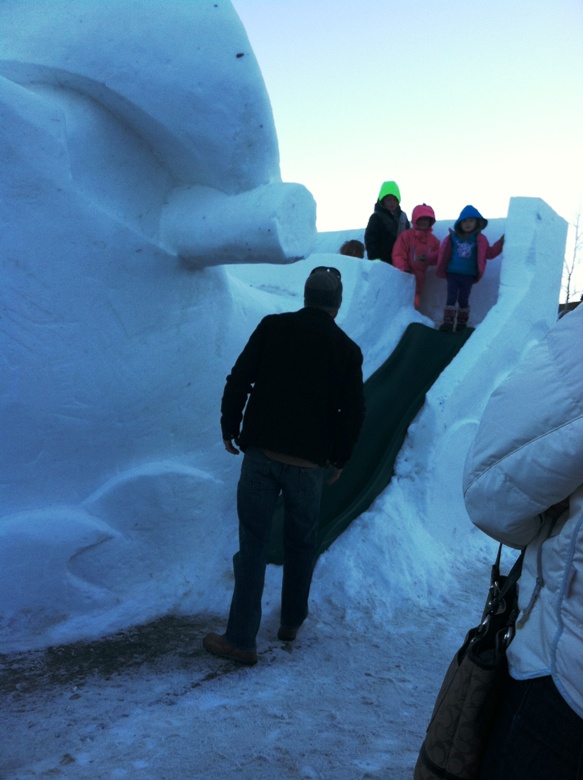Carving snow and ice In Breckenridge CO — you can do this at home!


BRECKENRIDGE, CO — Ready from some real fun in the snow? First you need a big plastic garbage can.
You fill it with snow and stomp it down really good. Turn the can upside down and you’ve got a block of snow.
Let it freeze overnight and you’re ready to become a snow carver. Get out your cheese graters, putty knives, spoons and paint scrapers, said Jeff Olsen, a retired teacher of Team Wisconsin snow carvers who has been snow carving since he was a college student in the 1960s as part of a fraternity-sorority winter competition.
“There’s no limit to what you can do,” he said.
With much of the nation covered in snow this week, and temperatures well below freezing, this is a great family cabin-fever-reducing activity. But here in Breckenridge, snow carving is a huge event each winter.

Team Wisconsin’s entry was butterflies.
Breckinridge is the home to the International Snow Sculpture Championship which brought teams from around the world—as far away as Mongolia and Estonia. It also draws thousands of tourists to see the huge sculptures—the carvers start with 12 feet tall blocks of snow that weigh 2 tons and in the course of 65 hours, carve amazing creations—one representing the Northern Sun from Team Finland and the dark side of the Moon from Team France. Team Mongolia depicts the legend where heroes wipe out the enemy’s forces by destroying a three headed monster. At night through Feb. 2, they’re lit up by colored lights.

Ten year old Alexa Dwyre was impressed. “I know how hard it is to make something out of snow,” the Aurora, CO girl explained.
“ I like all the detail. They’re just cool,” added her brother Dominic, 12.
The winner—for the only second time in the 24 years of this competition—was team Breckinridge, which depicted children tubing down a hill while Ullr, the norse god of snow whips up a storm in the back. Keith Martin, the captain of the team (check out his website www.snowandicecarving.com) explained that kids get so excited when they see snow –“their imaginations go wild with all the fun they are going to have.“
“In Breckinridge, we wake up to fresh snow and we’re excited and we enjoy it.” The sculpture he added—and the judges agreed–can’t help but make you smile thinking of times you were a kid out playing in the snow or with your kids or grandkids.
“It’s all about how we should return to having fun in the snow,” he said.

The crowds of families walking around in the late afternoon looking at the sculptures certainly weren’t having any trouble doing that.
Lily Patrick, 10, and her brother Westin, 9, who live in Fort Collins, CO were especially impressed because, she said, “I’ve tried and failed to make anything out of snow…this is so different from what you see in normal life! Her favorite—the sculpture of the dark side of the moon.
The German sculpture, which took second place was entitled Apecheta “Where the Flow Begins.” An Apecheta is a small pile of rocks built along a trail to atone for sins and serve as trail markers. They were best known in Latin America to be built by the Incas who would add a stone to an existing Apecheta and say a prayer for locuk in their travels. Germany’s interpretation was elegant round discs balanced on top of each other.
The Lithuanians carved a homage to ancient forests that are disappearing while Team Great Britain depicted the Somerset Hunky Punks—the beasts who are carved on the stone church towers to ward off evil spirits and date back to the 15th century
“They’re so artistic,” offered Kylie Hess, who also is in elementary school.
“It’s amazing that you could make these out of snow,” added Camdyn Wather, 9 from Denver.
Certainly it takes a lot of skill, a lot of hours and tools—everything from a yardstick (for measuring), chisels (to chip hard snow), saw, trowels and even a cheese grater that’s used to define the shapes.
But Tom Day, a local realtor and member of Team Breckenridge said it doesn’t have to be that complicated. When his son was three, they used the garbage can trick and carved a dolphin. “It just took a half hour he said. “It was easy.”
This isn’t the only snow sculpture competition, though it is one of the larger international ones “and growing every year,” said Rob Neyland, who was instrumental in starting the competition here 24 years ago. There are no cash prizes—just pride, a basket of goodies and a bottle of champagne.
Vermont team member Alex Dostie, from Burlington, said it might be easier to get a large refrigerator sized cardboard box once it’s filled with packed snow, you can just cut away the box and start carving
“Pick an animal shape,” he suggests “Or maybe a flower. Go buy a small toy—like a train so you have a 3-D model.”
It’s striking that these carvers were all ages and professions—the captain of team Vermont owns a tech marketing company; another a frame store. One of the women is a white water raft guide; another manages a local clothing store
Jeff Olsen, the retired Wisconsin teacher, said he especially enjoyed teaching his students to snow carve and to bring them to local competitions.
In case you are wondering, Olsen, who spends part of the winter in Florida every year, says sand carving is much more work. “YOU have to pack your own sand,” he explained. “They pack the snow for you.”
Guess that’s a job for mom and dad.
